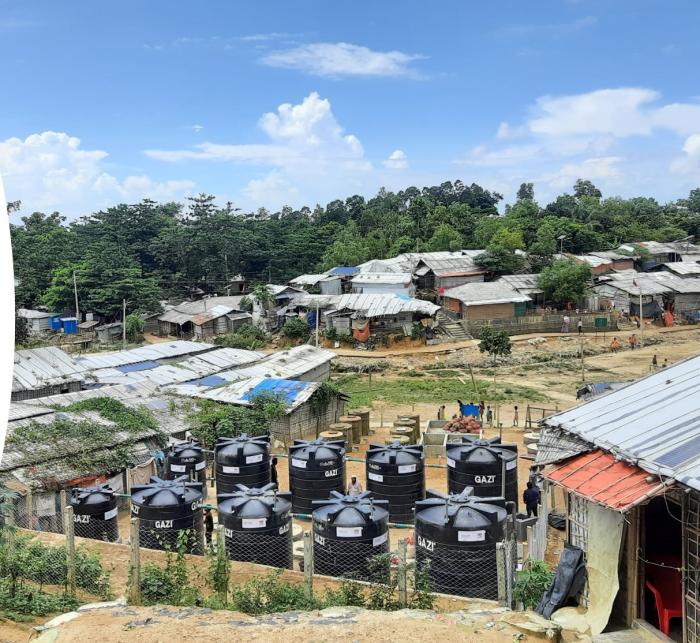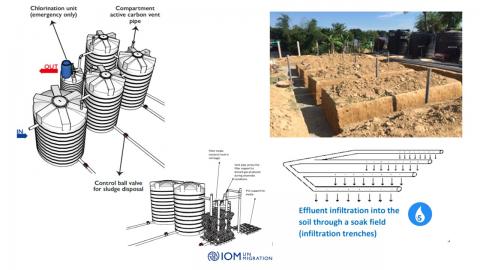IOM Decentralized Wastewater Treatment System (DEWATS)in the Rohingya refugee camps in Cox’s Bazar, Bangladesh.
Organisation that implemented the case study
Description of the emergency context
Some 929,606 Rohingya refugees currently reside in 33 congested camps formally designated by the Government of Bangladesh. Following the outbreak of extreme violence in Rakhine State of Myanmar on 25 August 2017, an estimated 687,000 Rohingya refugees crossed the border into Cox’s Bazar, Bangladesh. Persecution has driven Rohingya refugees across the border into Bangladesh repeatedly. Significant influxes have occurred following violence in Rakhine State in 1978, 1992, 2012, and again in 2016. By far the largest and fastest refugee influx from Myanmar into Bangladesh began in August 2017.
The IOM WASH Unit in Bangladesh is the area focal agency for 12 camps and has been working in Cox’s Bazar since 2014. From the influx in August 2017, the unit has been coordinating the overall WASH response in its area of responsibility. IOM also works with partner agencies to ensure the ongoing operation and maintenance (O&M) of facilities.
In highly congested settings, such as the Rohingya camps, WASH actors face challenges to deliver faecal sludge treatment processes which provide an effective removal of pathogens. The challenges are largely due to limitations on space, which places constraints on to the ability to include appropriate, safe and sustainable aerobic processes in the treatment train.
Description of the treatment process
In 2018, the IOM WASH programme designed a new treatment mechanism—the Decentralized Wastewater Treatment System (DEWATS). The treatment mechanism works by solids/liquid separation through settlement and filtration as well as digestion of solids under anaerobic conditions. The Plastic DEWATS are composed of two processes: The Anaerobic Treatment System (ATS, in plastic tanks with filter material). The 2 first tanks allow the separation of liquid and solid as a traditional septic tank and the next tanks are filled with coconut husks to allow upflow filtration of the wastewater.
- It can serve more than 5000 ppl with only a surface of 120m2. So It doesn’t require a lot of space. And we know that land allocation for faecal sludge treatment systems is very often a challenge in congested humanitarian settings.
- Its Environmentally friendly - there is no need of power supply or chemicals
- Its easy to operate and maintained. It doesn’t require specific skills
- Material is cheap and locally available.
- The system is totally sealed. There is no smell or exposure to wastewater
- There is good treatment performance before infiltration with 96% of reduction of faecal coliform and 99.6% of reduction of helminths, 87% reduction of BOD, 83% reduction of COD; TSS reduction 96%.
In June 2019, Oxfam and Arup conducted a comparison study between 14 treatment systems used in the Rohingya refugee camps. The IOM DEWATS was placed in the best position for the following indicators: capacity to scale up, treatment effectiveness, skill requirement, whole life cost (WLC) and environmental and social context. The WASH Sector has recommended its design and IOM DEWATS are now widely used in this context. This system has the capacity to scale up by adding plastic tanks which create multiple treatment possibilities. This portable version, using locally available plastic tanks, can be directly deployed in the field and can be replicable for different humanitarian contexts.
Assessment & design (feasibility)
The total cost for IOM DEWATS is USD 10600, which includes: • all material supplies: plastic tank; fittings; filter media (coconut husk); material for infiltration bed (stone chips; PVC pipes; geotextile), material for fencing, etc. all construction work: site preparation; digging of infiltration trenches and sludge pits; fixing of hardware materials for tank; etc.
All the material used for this system is procured locally and can be found almost everywhere in the world.
The Site identification is the first stage of project implementation and is essential. The camps are extremely congested, and it can be very challenging to identify a suitable location to accommodate the DEWATS. Some key parameters must be considered during the assessment:
- The population targeted considering that one system can serve maximum 5,170 users.
- The surface area of the site: 65 m2 of land needed for the ATS and 52m2 of land required for infiltration trenches.
- The soil infiltration rate must be tested and calculated for each site.
- The groundwater levels must be measured. If the water table in certain periods of year reaches the depth of 2.5 meters or less (i.e. less than 1.5 meters space from the bottom of the trench), the desludging pits and infiltration trenches won’t be fully operational during the year.
- Flood prone area must be avoided imperatively.
- The infiltration trenches must be located at least 30m from the nearest water point.
Construction
Site development:
The topography in the camps varies. Most of the camps are in hilly areas. Valleys should be avoided as they can be prone to flooding or zone that have shallow water table which is not suitable for DEWATS. Consequently, most of the suitable sites for DEWATS installation will be identified on the hillsides. It’s essential to coordinate with site management, site development units and SMEP to assess the risk of landslides and to take action through slope protection and site development. The site must be properly leveled and compacted to accommodate the different components of DEWATS and ensure stability when the system will be operational.
Safety:
The contractor in charge of construction should have clear EHS measures in place. They should provide to workers involved in the construction personal protective equipment (PPE: including safety shoes, helmets and gloves).
The contractor is in charge to identify the risks linked to the construction work and briefed the workers accordingly.
The contractor is in charge to ensure dignified working conditions to the workers in the field by behaving with respect, providing safe working conditions, weather protection (against sun and rain), limited working hours, proper tools and equipment, etc. More specifications are defined within IOM agreement.
The contractor prevents public access to the construction site by clear sign and preventive measures adapted to refugees (site fencing, guard, sign board writing in Burmese, etc.)
Environment:
All waste produced by the construction are properly collected and disposed by the contractor in order to mitigate any negative impact on the environment and public health.
COVID-19 measures:
The IOM WASH programme in Cox’s Bazar has made adaptations to COVID-19 throughout 2020 through specific infection, prevention and control measures. It is expected that these will continue to be utilized in 2021 to ensure safe delivery, including training provided with adherence to physical distancing guidelines, wearing of face masks, adequate hand hygiene and adequate cleaning and disinfection of materials.
Inspection:
All tools and work equipment must be inspected regularly. IOM supervisor and contractor manager should be responsible for this continuous inspection. Inspections can take the form of a check list.
Refer to the BoQ for more details
Operation and maintenance
DEWATS performance:
According to the faecal sludge quality monitoring, the reduction of parameters tested between inlet and outlet is significant and demonstrates the effectiveness of the treatment mechanism.
The reduction is: FC = 96%; TS = 70%; COD = 83%; BOD=87%; TN=60%; TP =76%; and helminths = 99,6%. It is also showing that 80% of raw sludge samples tested with presence of vibrio cholera are free of this pathogen after treatment.
The average result of FC is 16,880 CFU/100ml and, considering that WHO standards for reuse of wastewater in agriculture is 20.000-40.000 cfu/100 ml, the quality of effluent after treatment would allow the reuse for irrigation. However, the quality of raw sludge is variable (which impacts the consistency of results) and the congestion in the camps cannot allow the reuse for irrigation.
The infiltration process remains an essential component of process where the soil characteristic is a key factor for the system. In case of any emergency like outbreak and it is decided that the effluent need to be disinfected, partners must add chlorine at the final stage to achieve a concentration of 15mg/l in tank 5 (2000liters).
Desludging and O&M (refer to SOP):
1 team of desludgers should be operating on daily basis to allow the optimum volume of faecal sludge per day (3.1m3 per day). Using two desludging pumps in series. One surface pump should be installed next to the latrines pits and moved during each desludging operation and a second pump should be installed permanently close to DEWATS. This second pump will allow to empty the pipe between the two pumps and reduce the risk of leaking after filling the sludge pit.
DEWATS is a recent technology and even if it is designed for minimum O&M requirements, it’s essential for partners to monitor the system on daily basis with dedicated trained staff in order to prevent and identify problems. You will find in the SOP examples of challenges that field staff could potentially face during operations
Monitoring tool should be used and filled on daily basis
Lessons learned
All volume of wastewater disposed and released by the DEWATS must be recorded in the monitoring tool and analyzed to ensure the proper use of the facility.
Possible additional treatment solution could be adapted to the DEWATS to improve the reduction of pathogens and discharge of effluent in the environment or reuse for irrigation.
Under ELRHA FSM challenge, IOM will pilot an innovative solution adapting solar heating system developed by the Asian Institute of Technology in Bangkok. This solution will allow to create thermophilic anaerobic digestion and monitor the reduction of specific pathogens under these conditions and with different hydraulic retention time (HRT).
During the development of project proposal, we reviewed existing literature and publications on reduction of pathogens for anaerobic systems and we realized that exposing the wastewater to high temperature is an efficient mechanism of pathogen reduction. In parallel, we had some discussions with the Asian institute of technology in Thailand and they presented their Solar septic tanks that they developed few years ago for schools and public facilities to treat wastewater using solar heating system.
With this new project we want to look at how we can improve the reduction of pathogens to minimize the infiltration process and make the solution replicable in conditions where infiltration is not possible.
Given the context of refugee settlements and disease outbreak risk factors, the research project will target three specific pathogens: the rotavirus and helminths - responsible for communicable diseases as AWD (Acute Watery Diarrhea) and helminthiases, designated by the Health Sector in Cox’s Bazar as a priority due to their high morbidity rate through faecal-oral transmission. The research will also focus on Vibrio cholera since is endemic in Bangladesh with an estimated 110,000 cases and 4,500 deaths each year. This innovation project will start on February 1, 2023.
Strengths
- It doesn’t require a lot of space.
- Its Environmentally friendly - there is no need of power supply or chemicals
- Its easy to operate and maintained. It doesn’t require specific skills.
- Material is cheap and locally available. Low CAPEX
- whole life cost (WLC) very low
- The system is totally sealed. There is no smell or exposure to wastewater.
- Capacity to scale up
Weaknesses
- The infiltration process remains an essential component of process where the soil characteristic is a key factor for the system. Valleys should be avoided as they can be prone to flooding or zone that have shallow water table which is not suitable for DEWATS. Consequently, most of the suitable sites for DEWATS installation will be identified on the hillsides.
- Not fire resistant.


Add new comment